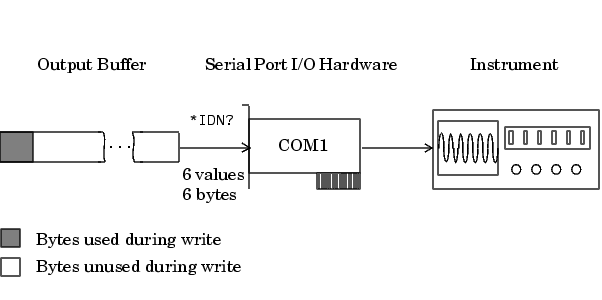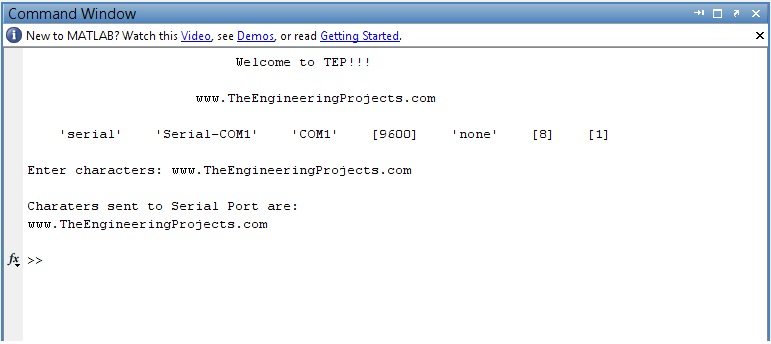Matlab Serial Port Example
- Matlab Serial Port Example List
- Matlab Gui Serial Port Example
- Matlab Serial Port Example Code
- Matlab Com Port Example
- Matlab Serial Port Read
The Serial Port Session
This example describes the steps you use to perform any serial port task from beginning to end.
Mar 04, 2015 Send data to Serial Port in MATLAB Its a quite simple project in which I am gonna send character over the serial port in MATLAB. In order to do so first of all, I am gonna create an object and assign it to serial port object in MATLAB. The serial port session is reinforced in many of the serial port documentation examples. To see a basic example that uses the steps shown above, see Example: Getting Started. Configuring and Returning Properties. This example describes how you display serial port property names and property values, and how you assign values to properties. Fwrite(obj,A) writes the binary data A to the device connected to the serial port object, obj. Fwrite(obj,A,'precision') writes binary data with precision specified by precision. Precision controls the number of bits written for each value and the interpretation of those bits as integer, floating-point, or character values.
Tpkd drivers free download - Drivers For Free, My Drivers, CopyTrans Drivers Installer, and many more programs. Extract, back up, restore, and update all device drivers on your system. Check out the 'The software requires installation of device driver tpkd,' error on launch of Pro Tools page at Sweetwater — the world's leading music technology. Feb 19, 2010 This software requires installation of device driver TPkd (HELP) 003, Mbox 2, Digi 002, original Mbox, Digi 001 (Win). Install device driver tpkd. Sep 30, 2019 TPkd Driver x32.The most popular version of this product among our users is 5.9. The product will soon be reviewed by our informers.

The serial port session comprises all the steps you are likely to take when communicating with a device connected to a serial port. These steps are:
Find your serial ports — Display a list of serial ports on your system using the
serialportlistfunction.Connect to a serial port device — Connect to a device for a specific serial port using the
serialportcreation function.Configure properties during object creation if necessary. In particular, you might want to configure properties associated with serial port communications such as the baud rate, the number of data bits, and so on. Alter the necessary device settings by configuring property values, read data, and write data.
Configure properties — To establish the desired serial port object behavior, assign values to properties using dot notation.
In practice, you can configure many of the properties at any time including during, or just after, object creation. Conversely, depending on your device settings and the requirements of your serial port application, you might be able to accept the default property values and skip this step.
Write and read data — Write data to the device using the
writelineorwritefunction, and read data from the device using thereadlineorreadfunction.The serial port object behaves according to the previously configured or default property values.
Disconnect and clean up — When you no longer need the serial port object, remove it from the MATLAB® workspace using the
clearcommand.
The serial port session is reinforced in many of the serial port documentation examples. To see a basic example that uses the steps shown above, see Query a Serial Port Device.

Tips
Before you can write data to the device, it must be connected to obj with the fopen function. A connected serial port object has a Status property value of open. An error is returned if you attempt to perform a write operation while obj is not connected to the device.
Matlab Serial Port Example List
The ValuesSent property value is increased by the number of values written each time fwrite is issued.
Matlab Gui Serial Port Example
An error occurs if the output buffer cannot hold all the data to be written. You can specify the size of the output buffer with the OutputBufferSize property.
If you set the FlowControl property to hardware on a serial object, and a hardware connection is not detected, fwrite returns an error message. This occurs if a device is not connected, or a connected device is not asserting that is ready to receive data. Check the remote device status and flow control settings to see if hardware flow control is causing errors in MATLAB®.
Note
If you want to check to see if the device is asserting that it is ready to receive data, set the FlowControl to none. Once you connect to the device, check the PinStatus structure for ClearToSend. If ClearToSend is off, there is a problem on the remote device side. If ClearToSend is on, there is a hardware FlowControl device prepared to receive data and you can execute fwrite.
Synchronous Versus Asynchronous Write Operations
By default, data is written to the device synchronously and the command line is blocked until the operation completes. You can perform an asynchronous write by configuring the mode input argument to be async. For asynchronous writes:
The
BytesToOutputproperty value is continuously updated to reflect the number of bytes in the output buffer.The callback function specified for the
OutputEmptyFcnproperty is executed when the output buffer is empty.
You can determine whether an asynchronous write operation is in progress with the TransferStatus property.
Matlab Serial Port Example Code
Synchronous and asynchronous write operations are discussed in more detail in Write and Read Data.
Rules for Completing a Write Operation with fwrite
A binary write operation using fwrite completes when:
The specified data is written.
The time specified by the
Timeoutproperty passes.Note
The
Terminatorproperty is not used with binary write operations.
Matlab Com Port Example
Supported Precisions
Matlab Serial Port Read
The following table shows the supported values for precision.
Data Type | Precision | Interpretation |
|---|---|---|
Character |
| 8-bit unsigned character |
| 8-bit signed character | |
| 8-bit signed or unsigned character | |
Integer |
| 8-bit integer |
| 16-bit integer | |
| 32-bit integer | |
| 8-bit unsigned integer | |
| 16-bit unsigned integer | |
| 32-bit unsigned integer | |
| 16-bit integer | |
| 32-bit integer | |
| 32- or 64-bit integer | |
| 16-bit unsigned integer | |
| 32-bit unsigned integer | |
| 32- or 64-bit unsigned integer | |
Floating-point |
| 32-bit floating point |
| 32-bit floating point | |
| 32-bit floating point | |
| 64-bit floating point | |
| 64-bit floating point |